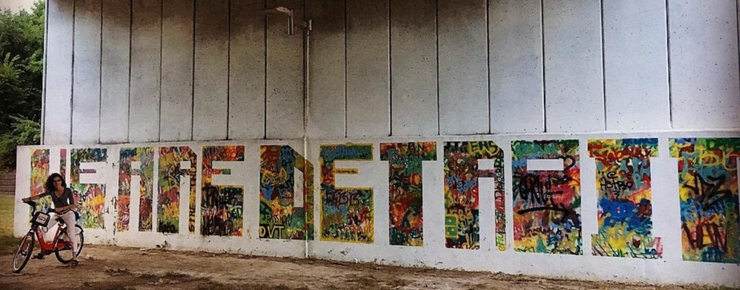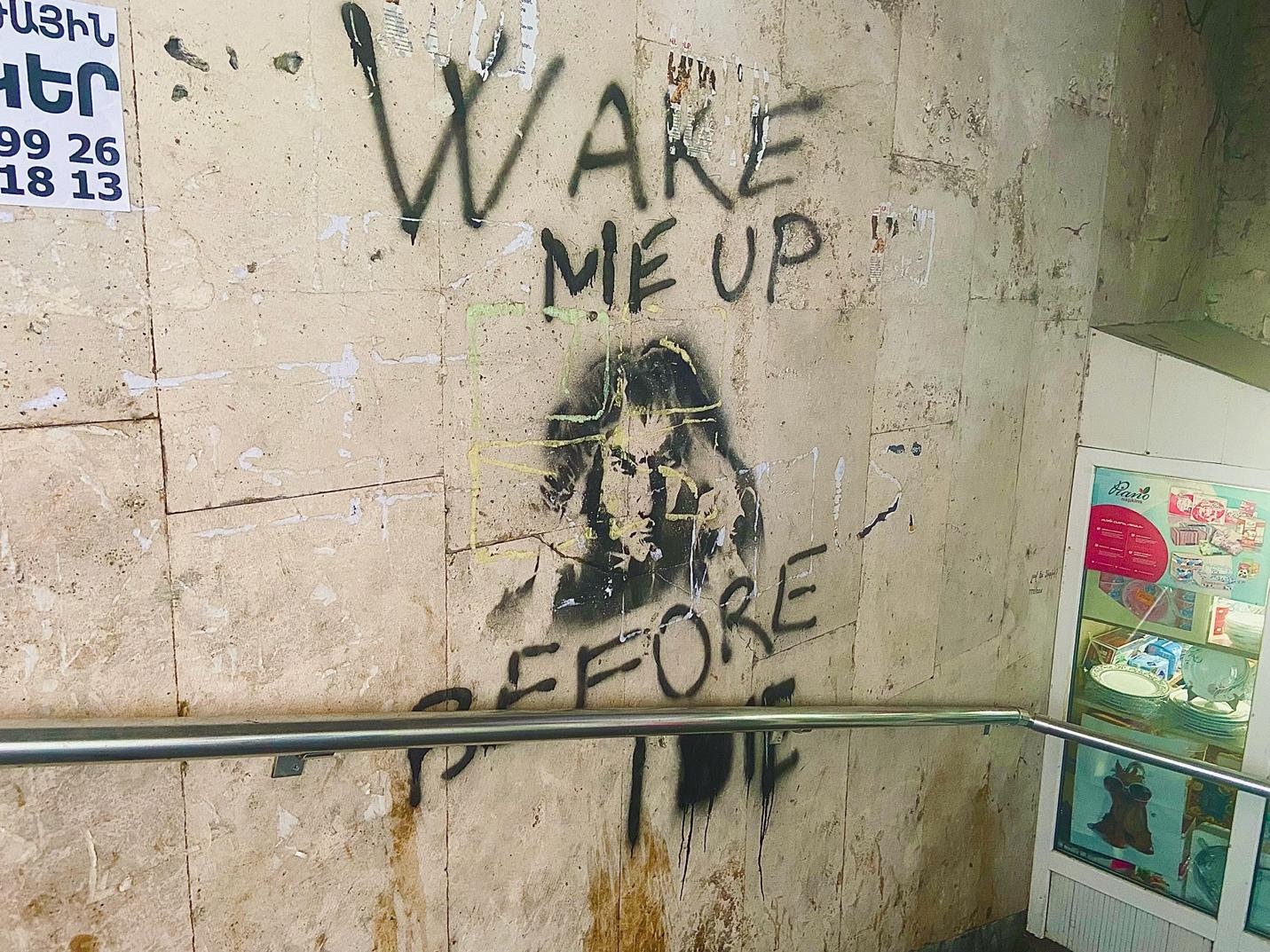Garegin Nzhdeh Square Metro
Photo Credits: All photo credits to author
Date of Photo: 2021
This is a graffiti piece I see every day when I run (often sweating) up and down the steps of my metro station, Garegin Nzhdeh. While in many ways, my new neighborhood is not like anywhere else I’ve ever lived – fruit stands next to my apartment, clothing and perfume shops all throughout the metro station where my aunt insists on finding cheaper products, and stray (though harmless) dogs roaming all around me – seeing this graffiti was my first reminder of home. Michigan.
This unexpected connection between Yerevan and Michigan came largely from a lens I’ve carried with me after growing up near Metro Detroit where seeing street art was a norm, but not always welcomed by city officials, similar to what I have been hearing about Yerevan. Only recently has graffiti in Detroit become encouraged through commissioned mural work.
These similarities between my previous home sites in Michigan neighborhoods and now Yerevan streets is not something I expected upon arriving to Armenia, yet it has been my favorite part of my introduction to this city.
One of the most exciting parts of the Yerevan street art culture is the Kond Gallery located in Yerevan’s oldest district – Kond. Similar to The Heidelberg Project, founded by one local artist in Detroit, Tyree Guyton, and later evolved into a larger project, Kond also was an initiative jumpstarted by Yerevan’s own contemporary muralist and graffiti artist, Sereg Navasdaryan and expanded to welcome several other local artists’ works. Throughout my walk around the Kond streets, there were constant other reminders of Detroit, too – particularly the Dequindre Cut. Both areas faced similar economic loss and a visibly lack of infrastructure funding to support the upkeep of local homes. At the same time, these two art neighborhoods are located in the middle of development and gentrification. The Dequindre Cut, for instance, is now a popular walking site, bicycling route and area for outsiders to visit, explore and snap Instagram-worthy photos.
Dequindre Cut, Detroit, MI
Date of Photo: 2018
Dequindre Cut, Detroit, MI
Similarly, the Kond Gallery provides a route for explorers to follow a path set up by local artists that takes you on a journey to see the reality of Post-Soviet urban decay and new-age development projects.
Kond Gallery, Kond, Yerevan, Armenia
Date of Photo: 2021
Kond Gallery, Kond, Yerevan, Armenia
Date of Photo: 2021
Kond is found next to popular busy streets with locals, diasporans, and tourists roaming the outdoor Western-resembling smoothie stands and restaurants near Saryan and Buzand Street.
Development project in Kond, Yerevan, Armenia
Date of Photo: 2021
In Kond, many of the homes are slanted, have poor insulation, made of thick brick and some appear to be vacant homes with a nonfunctioning structure including dilapidated roofs.
Kond, Yerevan, Armenia
Date of Photo: 2021
It appears that artists have even recreated these homes spaces with small touches of art – bringing these areas that represent the past, ruin and stagnation into the future with colors and hope for recreation and inspiration.
Kond, Yerevan, Armenia
Date of Photo: 2021
This is a common theme in Detroit’s Heidelberg Project that turns the abandonment of Detroit homes into outdoor art. Even less structured art displays are around Detroit in local neighborhoods including Woodbridge.
Home Garage, Woodbridge, Detroit, MI
Date of Photo: 2020
Most recently, Lansing, MI has also welcomed new murals with the development of city art initiatives such as Below the Stacks and the Lansing ArtPath. Lansing, like Detroit, faced the consequences of de-industrialization including the closure and temporary shut downs of auto plants and employee concerns over existing plants’ failure to provide adequate union benefits. The long-lasting effects of the past and its precarious economic conditions on local Lansingites is seen simultaneously as the city embarks on a new image of gentrification.
Old Town, Lansing, MI
Date of Photo: 2019
Old Town, Lansing, MI
Date of Photo: 2019
I’m also reminded of college campuses I’ve been on. Graffiti has been used to give a voice to the students who occupy the city’s streets with activist messages found around the campuses of Michigan State University (East Lansing) and the University of Michigan (Ann Arbor), similar to what I see when approaching Yerevan State University.
On my own campus at Michigan State, students transformed the Red Cedar River bridge with graffiti and messages. In Ann Arbor, the Graffiti Alley exists in an alleyway that welcomes the University of Michigan students and locals to turn their heads around all sides of the walls to follow the text of sarcastic messages and political stances of frustration.
Red Cedar River Bridge, Michigan State University, East Lansing, MI
Date of Photo: 2019
University of Michigan, Ann Arbor, MI
Date of Photo: 2021

Graffiti Alley, Ann Arbor, MI
Date of Photo: 2018
Similarly, when walking out of the Yeritasardakan (meaning “youth”) metro stop into the streets leading to Alex Manukyan Street where Yerevan State University is located, I immediately notice a slight shift to more activist and political ideas displayed.
Tunnel near Yerevan State University, Yerevan, Armenia
Date of Photo: 2021
Tunnel near Yerevan State University, Yerevan, Armenia
Date of Photo: 2021
As I’m one month into living in Yerevan and hoping to understand this city, its street art has surprisingly been a guide and source of clarity. I was not sure what to expect of Yerevan but knew I had some stereotypes of the place I was walking into – a rich history of folk dance, delicious cuisine and old-school lifestyle I learned about in the diaspora. But, the street art is so much more than this surface level understanding. The graffiti and messages represent the progress that was lacking in my awareness of Yerevan – the reality that the youth is leading the changes in this country, that as with any place in the world, there is frustration with local government, and that art continues to be a form of expression around the world.
This was my first introduction to seeing Armenia, the home, as a moving target, changing and developing rather than just an ancient story. Each day, I experience something new on the walls around me and while I’m still learning the Eastern dialect and slowly having more conversations with locals here, I realize that by simply walking in silence along Yerevan’s streets, I hear so much of what I came here asking – what is Armenia today? With half a year left to roam around and explore, I’m confident the street art will lead me closer towards an answer.
Inna Mirzoyan



